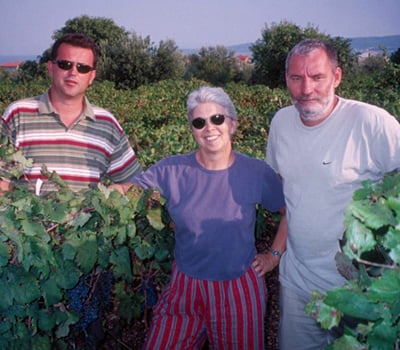

At the time, there were only a handful of vines left in Croatia, and despite interest from US growers in accessing that genetic material, it’s taken some time to process and propagate the Croatian plants.
Ivan Pejic and Edi Maletic, Meredith’s collaborators at the University of Zagreb, had scoured the Croatian vineyards looking for potential zinfandel matches. Last year, they planted the first significant block of the rediscovered vine material in Split on the Dalmatian coast, in the heart of the vine’s historic territory. This coming spring, says vineyard director David Gates, Ridge will plant the first blocks of Croatian vines on American soil—one acre of three different Croatian clones at Lytton Springs, plus a small increase block at Monte Bello. (Ridge played an instrumental role in funding the research in Croatia.)
“They’re ahead of us by a year; I’m pissed,” Gates joked recently when I visited him at Lytton Springs while working on a story on young-vine zinfandel for our February issue.
The crljenak selection they’re planting, Gates explains, was found along the northern Croatian coast. It came from a vineyard owned by a fireman, who was farming mixed varieties that his father had planted. The vineyard was mostly plavac mali—a cross of zinfandel and another native Croatian variety called dobricic—but in among the plavac mali were seven or so crljenak vines.
The pribidrag selections were found further south toward Dubrovnik, inland from Omis, in a valley with an abundance of limestone. A woman in her eighties, Gates says, had four vines growing in her garden. She recalled that her grandfather had planted the vines, and that pribidrag had been ubiquitous in the area at one time. The pribidrag selections that entered the US came from two of those vines.
All of the selections underwent microshoot tip tissue culturing, and the resulting clones are now presumably virus-free. Because the TTB only allows three names for a given variety, wines made from the selections must be labeled either “zinfandel,” “primitivo,” or “tribidrag;” tribidrag was the historical name for the grape in its native Croatia. (For those who want to dig deeper, they’re listed as zinfandel selections 42.1, 43.1 and 44.1 in the National Grape Registry.) http://ngr.ucdavis.edu/index.cfm
According to Meredith, one night Edi Maletic was Googling “tribidrag,” and ran across a reference to it in a paper written by Croatian historian Ambroz Tudor, who focuses on the history of trade in the Adriatic. Spurred by Maletic and Pejic, Tudor found a significant trail of references to tribidrag dating back to the 1300s: trade documents, deeds, tax documents, land records and wills. What’s now zinfandel, it turns out, was a fairly important grape in the Adriatic region for several centuries.
As to why it disappeared in Croatia, Meredith suspects it might be related to fungal diseases like powdery mildew and downy mildew, which arrived in Europe from North America in the 1800s. Like California, Croatia benefits from a mostly sunny Mediterranean climate. Unlike California, it gets periodic summer rains, which can encourage the growth of mold on thin-skinned grapes like zinfandel.
“Maybe plavac mali took over without people realizing what was going on,” she hypothesizes, “because it is more tolerant of disease pressure. It may be that crljenak will not be the best for the climate. Now, there are solutions that can be used, like chemical fungicides and leaf pulling. Still, it may be that zinfandel will never be an important variety there again. On the other hand, there’s a lot of economic incentive, of course, for the Croatians to grow zinfandel, as an internationally recognized variety.”
Turnabout is fair play, and Maletic and Pejic have already planted some California zinfandel selections alongside their crljenak and pribidrag, to see how the North American siblings fare on Croatian soil.
Meredith believes we’re still a long way from knowing how Croatian pribidrag/crljenak/tribidrag may differ from California’s own heritage selections. “There really haven’t been any valid comparisons,” she says.
It’s quite possible that the Croatian material will present new possibilities. Since the 1990s, growers in California have had access to primitivo, the southern Italian version of zinfandel that arrived in Puglia in the mid-1800s or earlier.
Anecdotal evidence suggested that primitivo, with its smaller berries and looser clusters, was indeed somewhat distinct from the lineage of plant material that was brought to California. Recent research seems to confirm those observations: Planted alongside a range of California heritage selections at the UC¬¬¬–Davis’s experimental vineyard in Oakville and farmed identically, the primitivo selections are clear outliers, ripening earlier, acquiring sugar more quickly and giving lower yields.
Some of the growers and winemakers I consulted for my recent zinfandel piece in our February print issue suggested that primitivo’s exuberance made it, at best, a minor contributor to a balanced zinfandel-based blend. Hugh Chappelle at Quivira was more bullish on primitivo, finding that it was turning out to be quite useful at their vineyard on the Dry Creek bench, where he’s able to lower the pH and brighten the acidity of the estate zin by co-fermenting zinfandel and primitivo, ultimately creating a more balanced wine.
“It freshens the wine aromatically, even though the wine’s a little bit harder,” he says.
As to whether the Croatian material will produce interesting wine in California (or Croatia, for that matter), the jury is still out—it has yet to find its way into an actual bottle.
This is a W&S web exclusive feature.
Longtime senior editor at Wine & Spirits magazine, Luke now works for the Stanford Technology Ventures Program.
This is a W&S web exclusive. Get access to all of our feature stories by signing up today.
















